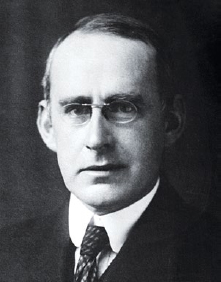1924
Eddington’s Mass-Luminosity Relation
Arthur Stanley Eddington (1882–1944)
Even though astronomers were classifying stars based on properties such as color, temperature, and intrinsic brightness, it took much longer to figure out how stars actually work. Why do they shine? Where to do they get their energy? What’s happening inside a star? One scientist whose work was important in answering such questions was the British astrophysicist Arthur Stanley Eddington.
Eddington was interested in understanding the process of gravitational collapse of nebular gas and dust to form a star. Astronomers knew that gravity was responsible for pulling the gas into a sphere and causing it to compress. But what stopped gravity from collapsing stars down to smaller and smaller sizes? In 1924 Eddington published a detailed model of the way radiation pressure—an outward force created by the super-high temperatures and pressures inside a star—balances gravity and allows the stars to reach their equilibrium sizes.
Eddington’s stellar interior models allowed him also to determine that there is a simple relationship between a main sequence star’s luminosity and its mass: a star that is twice as bright as another will be more than ten times as massive (specifically, LOC M3.5). Thus, based on his work, it was possible to estimate the mass of a star just by measuring its apparent brightness and its distance, and therefore astronomers could show that the main sequence is the mass-dependent “lifeline,” an evolutionary track taken by about 90 percent of all stars.

Photo of Arthur Stanley Eddington.
Neither Eddington nor anyone else at the time knew why this so-called mass-luminosity relationship worked, or how and why radiation pressure was generated inside a star. A leading theory was that gravitational contraction provided the energy. Eddington speculated that perhaps nuclear fusion could generate the required energy, but the idea was met with skepticism until the late 1930s.
SEE ALSO Birth of the Sun (c. 4.6 Billion BCE), Star Color = Star Temperature (1893), Main Sequence (1910), Nuclear Fusion (1939).
The NASA Solar Dynamics Observatory obtained this spectacular ultraviolet view in August 2010 of a dark coronal hole in the Sun’s atmosphere, a region where solar wind particles stream out into space, generating auroral displays in our atmosphere.
